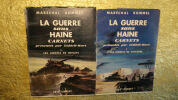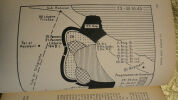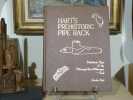531 books for « hart b l j »Edit
-
Type
Book (508)
Music sheets (23)
-
Language
Dutch (1)
English (16)
French (514)
-
Century
19th (6)
20th (287)
21st (71)
-
Countries
Belgium (27)
Canada (2)
Denmark (4)
France (444)
Netherlands (1)
Switzerland (53)
-
Syndicate
CLAM (2)
ILAB (265)
NVVA (3)
SLACES (3)
SLAM (249)
Topics
- Alsace (9)
- American literature (1)
- Annals (1)
- Architecture (2)
- Army (9)
- Art deco (1)
- Asia - orient (1)
- Berry (2)
- Biography (2)
- Birds (2)
- Botany (1)
- Bradley (1)
- Cabu (1)
- Central america (1)
- Chemistry (1)
- Children’s books (3)
- Comic strip (6)
- Congo (2)
- Cooking (3)
- Crime (3)
- Culinary art (3)
- Dance & ballet (1)
- Dancing (1)
- Dedication (1)
- Denaeyer marcel-e (2)
- Detective novels (5)
- Dictionaries (1)
- Education (2)
- Education - morals (2)
- Egypt (3)
- Egyptology (1)
- Eiffel tower (3)
- English (20)
- Entomology (1)
- Erotic (4)
- Fox (2)
- Genealogy (2)
- Geography (3)
- Geology (1)
- Germanic languages (4)
- Germany (3)
- Hackney (5)
- Health (2)
- History (13)
- Honey (1)
- India (1)
- Industry (1)
- Invertebrates (1)
- Italian (1)
- Jazz (2)
- Liddell hart (29)
- Literature (59)
- Magazine (4)
- Medicine (3)
- Military arts (2)
- Miller (2)
- Music (2)
- Navy (4)
- Newspapers press (4)
- Odontology (2)
- Ornithology (3)
- Ouvrieu rené (5)
- Painters (1)
- Palaeontology (2)
- Paradise (2)
- Paris (1)
- Philosophy (3)
- Poe edgar (2)
- Poetry (5)
- Psychology (2)
- Review (6)
- Reviews (4)
- Romance (4)
- Ruth (1)
- Scores (24)
- Shakespeare william (2)
- Songs (23)
- Spying (2)
- Sudan (2)
- Swallow (1)
- Telephone - telegraph (2)
- Tennis (4)
- Theatre (3)
- Translation (1)
- United kingdom (2)
- United states (2)
- Valmy (1)
- Various (3)
- Waltz (1)
- War (26)
- White tiffany (1)
- Wilde oscar (1)
- Wildlife (2)
- Williams tennessee (5)
The Concept of Law. - [A CORNERSTONE OF LEGAL PHILOSOPHY]
Oxford, Clarendon Press, 1961. 8vo. Orig. full black cloth, orig. red, white and black dust-jacket, not price-clipped. A very nice, clean, and fresh copy in an excellent dust-jacket with just a tiny bit of soiling and a few small tears to extremities (no loss). An old owner's name in pencil erased from front free end-paper. A few faint marginal notes in pencil. An excellent copy. X, 263, (1) pp.
The hugely important first edition, review-copy with slip laid in, of Hart's seminal main work, a cornerstone of legal philosophy and probably the most important book in legal philosophy of the 20th century.The legal philosopher Herbert Lionel Adolphus Hart (1907-1992) is famous for his immensely influential contributions to legal philosophy, including his theory of legal positivism, which is developed on the basis of analytic philosophy. By using the tools of analytic philosophy and philosophy of language, clearly inspired by philosophers like Wittgenstein, in his attempts to solve the problems of legal theory, Hart came to revolutionize the way that jurisprudence and philosophy of law is conducted in especially America and Great Britain, and as such, his work is considered the main reason why English-language theory of law is now accepted as a natural part of philosophy. In 1952 Hart began what is now called his Holmes lecture, Positivism and the Separation of Law and Morals"", and it is from this lecture that his masterpiece work ""The Concept of Law"" emerged. The work was first published, as it is here, in 1961, and numerous issues of it later appeared. In 1994 a new, posthumous, edition was published, establishing the lasting influence of the work.""The Concept of Law"" poses the main question, whether all laws can be understood as being coercive orders or moral commands. It analyses the relation between law, coercion, and morality and comes to the conclusion that there is no logically necessary connection between neither law and coercion nor low and morality. Had one assumed such a necessary connection, Hart claims, one would have oversimplified the relation between the three and would have misunderstood the content, purpose, function and application of a number of laws.On this basis, Hart develops a distinction between primary and secondary legal rules, the primary rule being that which governs conduct, and the secondary rule being that which allows alterations of the primary one. He furthermore distinguishes between internal and external points of view of law, and not least, he developed the idea of the Rule of Recognition, a central part of his theory of logical positivism, a meta-rule that underlies any legal system and which differentiates between norms that have authority of law and those that do not. The Rule of Recognition identifies legal validity within the legal system.""The Concept of Law"" must be said to be the most important and original work of 20th century legal philosophy. Though Hart's contribution to the study of jurisprudence and legal philosophy has been enormous in general, ""The Concept of Law"" occupies a seminal place within this study and is considered his absolute masterpiece. Its influence has been enormous, and a huge growth in the quantity of scholarship of the area of jurisprudence and legal thought can be traced directly back to this work. Hart's combination of twentieth-century analytic philosophy with the jurisprudential tradition of Jeremy Bentham has had an immense influence on legal though and continues to have so. Most important legal scholars of the 20th century are influenced by Hart in one way or the other, for instance John Rawls, and Ronald Dworkin, who, however, disagrees with his theories.
General Ability, its Existence and Nature. (Original off-print) From The Journal pf Psychology, Vol. V. Part 1, March 1912. - [PIONEERING FACTOR ANALYSIS - PRESENTATION-COPY]
Cambridge, (1912). 8vo. Original printed wrappers. A bit of wear to extremities. A few nicks and creases. Inscribed to front free end-paper and with a few ownership-stamps (of the presentee- Dr. Richard Goldschmidt). (2) pp., pp. (51) - 79.
Original off-print of Spearman and Hart's groundbreaking paper on general ability, which created a conceptual framework for factor analysis and played an enormous role in IQ-testing, with an original handwritten and signed presentation-inscription from Spearman to Richard Goldschmidt (fellow psychologist and director of the Institute for Experimental Psychology at the University of Münster), expressing friendly remembrance of the Berlin congress 1912. ""Spearman, with a collaborator, Hart, pioneered the use of the pattern of correlations between a set of measures to determine the number of abilities (Hart & Spearman, 1912). The tetrad difference criterion could test if a single common factor (g, or general ability, presumably) could account for individual differences on the measures. If the tetrad differences were zero, then a single common factor was supported, but if not, then it was unclear how many common factors were needed."" (Susan E. Embretson: The Second Century of Ability Testing: Some Predictions and Speculations, 2001, p. 11) Charles Edward Spearman (1863 - 1945) was a famous English psychologist known both for his work in statistics, but primarily for his work on human intelligence. He was a pioneer of factor analysis, he gave name to the Spearman's rank correlation coefficient and did seminal work on models for human intelligence, including his theory that disparate cognitive test scores reflect a single General intelligence factor, and he famously coined the term ""g- factor"". The g-factor, also known as General intelligence, refers to the existence of a broad mental capacity that influences performance on cognitive ability measures. Terms such as intelligence, IQ, general cognitive ability, and general mental ability are today used interchangeably to mean the same thing as general intelligence or g-factor. ""Charles E. Spearman, in full Charles Edward Spearman, (born September 10, 1863, London, England-died September 17, 1945, London), British psychologist who theorized that a general factor of intelligence, g, is present in varying degrees in different human abilities.While serving as an officer in the British army (1883-97), Spearman came to believe that any significant advance in philosophy would come about mainly through psychology. Over the next 10 years he worked intermittently with Wilhelm Wundt, the founder of experimental psychology, at the University of Leipzig, and he took his Ph.D. there. He joined the faculty of University College, London (1907), and was professor there from 1911 to 1931.Spearman's attempt to establish general, fundamental laws of psychology was based on his statistical work in determining correlations among mental abilities, reflected in his classic paper, "" 'General Intelligence,' Objectively Determined and Measured"" (1904). He sought to interpret correlations among several variables on the basis of a specific factor for each variable and a factor common to all. Because measures of seemingly different mental abilities consistently indicate correlations, he concluded that the prevalence of positive correlations must result from the general factor, g. By 1912 he and a coworker had developed an order of correlation coefficients separating various performances into the general factor, g, and varying specific factors, s1, s2, and so on."" (Encycl. Britt.). The present paper is of the utmost importance, as it is here that Spearman, in collaboration with Hart, develops a conceptual framework for factor analysis, pioneering the use of the pattern of correlations in order to determine the number of abilities, one of the fundamental principles for psychometric methods.
LYTTELTON Lord GEORGE, HART-DAVIS RUPERT
Reference : RO60124225
(1985)
ISBN : 0719542464
THE LYTTELTON HART-DAVIS LETTERS, Correspondance of george Lyttelton and Rupert Hart-Davis, Volumes One and Two, 1955-1957
John Murray. 1985. In-8. Broché. Bon état, Couv. convenable, Dos satisfaisant, Intérieur frais. 443 pages.. . . . Classification Dewey : 420-Langue anglaise. Anglo-saxon
Edited and Intro. by Rupert HART-DAVIS. Classification Dewey : 420-Langue anglaise. Anglo-saxon
Histoire de la Seconde Guerre mondiale
État : Bon état - Année : 1990 - Format : in 8° - Pages : 741pp - Editeur : Fayard - Lieu d'édition : Paris - Type : Broché - Divers : Dos très légèrement plié. Une tâche sur la tranche. - Commander rapidement : https://www.bons-livres.fr/livre/b-h-liddell-hart/4082-histoire-de-la-seconde-guerre-mondiale?lrb
Un des meilleurs livres sur la Deuxième Guerre mondiale par un spécialiste de la guerre, en général, et de celle des blindés, en particulier, qui a eu l'occasion d'interroger, à chaud, les généraux allemands, prisonniers en Angleterre, même si l'auteur, très britannique, fait peu cas du rôle, pourtant capital, de la France dans la guerre. Traduit de l'anglais par Jean-Paul Constantin. Avant-propos de Lady Liddell-Hart. Préface et postface du général Beaufre. ˮSir Basil Liddell Hart, esprit passionné et curieux, nous laisse une grande leçon qui est celle de la vie. Dans le domaine militaire, la vérité, non seulement celle du passé mais celle qui se vérifira dans l'avenir, ne peut généralement pas être trouvée par les voies officielles de la hiérarchie, trop facilement conformiste. Il est donc capital qu'il existe des chercheurs privés, capable de donner libre cours à laur imagination et à leur initiative.ˮ (Préface du général Beaufre)
Phone number : 09 63 58 85 14
Dfense de l'Europe / Liddell Hart / Rf30367
Calmann-Lvy Broch D'occasion bon tat 01/01/1951 100 pages
Thomas Hart Benton an american original
1989 Kansas-city, the Nelson - Atkins Museum of Art ,1989, 18 x 29 cm ,24 cm , souple, good condition,
exhibition catalog,curated by Henry Adams.
Lorenz Hart : a Poet in Broadway.
New York Oxford University Press 1994 1 vol. broché in-8, broché, couverture illustrée, 390 pp., quelques photos en noir, index. Texte en anglais. Très bon état. Exemplaire provenant de la bibliothèque d'Alain Resnais.
Dazzler : the Life and Times of Moss Hart.
New York Alfred A. Knopf 2001 1 vol. relié in-8, cartonnage sous jaquette illustrée, 462 pp., photos en noir hors-texte, index, bibliographie. Texte en anglais. Très bon exemplaire. Exemplaire provenant de la bibliothèque d'Alain Resnais.
Hart's Prehistoric Pipe Rack: Prehistoric Pipes of the Mississippi River Waterways - East.
Hart Publishers Bluffton, In. S.D. (1978) In-4 carré ( 280 X 215 mm ) de 272 pages, cartonnage de rexine caramel décoré de motifs dorés. Nombreuses illustrations dans le texte et planches hors-texte. Très bel exemplaire.
Crustaceorum Catalogus. Pars 4/5. Ostracoda I. Podocopa I. Fam. Entocytheridae / Caprellidae II. Superfam. Cyamidea.
1975 104 p, paperbound. Library stamps.
Crustaceorum Catalogus. Pars 4/5. Ostracoda I. Podocopa I. Fam. Entocytheridae / Caprellidae II. Suprfam. Cyamidea.
1975 104 p., paperbound. Library stamps and markings.
Memoire sur l'application de la pression hydraulique, traduit par Georges Monbro.
1875 P.DEJEY 1875,in8 broché, Extrait du “Bulletin mensuel de la Société des anciens élèves des Ecoles... d'arts et métiers”,juillet 1875,47p.+11 planches ht,envoi autographe sur couverture,
bon état, Remise de 20% pour toutes commandes supérieures à 200 €
Oscar Wilde avec une introduction de Rupert Hart-Davis
traduit de l'anglais par Henriette de BoissardLettres d'Oscar Wilde - tome I et tome II - Ed. nrf. Gallimard - coll. Du Monde Entier, 2 vol. in-8 broché - 1966 - 584 pages + 686 pages - Ed. nrf. Gallimard ,parfait etat
Ray A6*
Histoire mondiale de la stratégie.
Plon, 1962, pt in-8°, xii-454 pp, traduit de l'anglais par Lucien Poirier, broché, bon état. Edition originale française, bande éditeur conservée : « Par le Clausewitz du XXe siècle »
Il n'y a guère, en matière de stratégie, de plus grand nom que celui de Liddell Hart. Ses conceptions, souvent prémonitoires, ont joué un rôle déterminant, des deux côtés, lors de la dernière guerre. Aussi bien ce livre qu'il a consacré à l'histoire de la stratégie fait-il le point décisif dans un domaine où les approximations inspirées et les vues cavalières sont trop souvent de mise. Il ne tient pas son autorité de sa seule méthode, de sa hauteur de vues, de sa rigueur spéculative. Il met aussi en œuvre une érudition sans faille qui nous instruit des batailles de l'Antiquité et du Moyen Age comme des guerres de l'époque moderne. L'ouvrage s'évade de l'austérité que suppose son propos initial. Car, au-delà des calculs et des prévisions où la stratégie semble trouver tant de délices aiguës, c'est toute la psychologie du combat - et cette part héroïque et cruelle de nous-mêmes qui souffre de victoires inassouvies - que le livre de Liddell Hart met en cause, en nous guidant, avec maîtrise, dans les entrelacs de la moins hypocrite de toutes les sciences. Un ouvrage de référence paru pour la première fois en 1954, et devenu un classique.
Histoire mondiale de la stratégie.
Plon, 1962, pt in-8°, xii-454 pp, traduit de l'anglais par Lucien Poirier, broché, qqs rares soulignures stylo, bon état. Edition originale française
Il n'y a guère, en matière de stratégie, de plus grand nom que celui de Liddell Hart. Ses conceptions, souvent prémonitoires, ont joué un rôle déterminant, des deux côtés, lors de la dernière guerre. Aussi bien ce livre qu'il a consacré à l'histoire de la stratégie fait-il le point décisif dans un domaine où les approximations inspirées et les vues cavalières sont trop souvent de mise. Il ne tient pas son autorité de sa seule méthode, de sa hauteur de vues, de sa rigueur spéculative. Il met aussi en œuvre une érudition sans faille qui nous instruit des batailles de l'Antiquité et du Moyen Age comme des guerres de l'époque moderne. L'ouvrage s'évade de l'austérité que suppose son propos initial. Car, au-delà des calculs et des prévisions où la stratégie semble trouver tant de délices aiguës, c'est toute la psychologie du combat - et cette part héroïque et cruelle de nous-mêmes qui souffre de victoires inassouvies - que le livre de Liddell Hart met en cause, en nous guidant, avec maîtrise, dans les entrelacs de la moins hypocrite de toutes les sciences. Un ouvrage de référence paru pour la première fois en 1954, et devenu un classique.
Dracula.
Paris, Presse de la Cité, 1992 14 x 22, 212 pp., photos en couleurs, broché, bon état.
d'après le scénario de James V. Hart, tiré du roman de Bram Stoker.
C. Hart Merriam,North American Fauna.D. C. United States Department of Agriculture
Reference : 20098
North American Fauna. No 8. Monographic Revision of the Pocket Gophers, Family Geomyidae (Exclusive of the Species of Thomomys).
Washington, D. C. United States Department of Agriculture,1895,lst ed. 258 p., 71 figs, 19 pls, 4 col. maps, paperbound. Unopened copy
Remise de 20% pour toutes commandes supérieures à 200 €
L'Alternative militaire : Deterrent ou defense,Traduit de l’anglais par Henri DEFAIX
La Table ronde, Paris, 1960, Broché,294 p. Bon état
Remise de 20% pour toutes commandes supérieures à 200 €
Montbéliard Belfort, France régions, 1989, in4° relié, jaquette, 98pp
Album de photos édité par la ville de Montbéliard Langue: Français
BROEDERSCHAP Heilig Hart Jesus in O.L.V. kathedraal te Antwerpen - (Konvoluut) 4 drukken in één band. - Convolute (4 imprints in one binding).
" 1) Korte Onderrigting over de devotie tot het Heylig Hert ons Heere Jesus-Christus...Broederschappen opgeregt o.a. in de Parochiale Kerk van Onze-Lieve-Vrouw tot Antwerpen, Antwerpen, H.P. Vander Hey (approb. van 1825), 48 pp. 2)Devotie tot het Godlyk Hert van onzen Heere Jesus-Christus; uyt het italiaensch vertaald...Antwerpen, G.J. Bincken, (approb. van 1770), frontispiece met hart in kopergravure + 190 pp + (4)(index). 3) Aenneming in het Broederschap van het H.Hert van Jesus opgeregt in de Parochiaele Kerk van O.L.Vrouw tot Antwerpen, 8 pp, gedrukt bij Vander Hey, s.d. 4) Onderrigting en gebeden tot het verdienen der Aflaeten vergund aen de XIV Statiën van Jerusalem, opgerigt in de parochiaele Kerk van den H. Carolus Borromaeus te Antwerpen, Drukkery van G. Van Merlen, s.d., 24 pp. In-8°, vollederen band uit de tijd (slijtage sporen)."
Richard Hart Bread
Clarkson Potter (11/2024)
LIVRE A L’ETAT DE NEUF. EXPEDIE SOUS 3 JOURS OUVRES. NUMERO DE SUIVI COMMUNIQUE AVANT ENVOI, EMBALLAGE RENFORCE. EAN:9780593234297
France, These football times - Henry, PSG, st-etienne, carre magique, ron-jay, clairefontaine, pires, platini, cantona, le havre, djorkaeff, le classique, monaco, ginola - The makinf of thierry henry
THESE FOOTBALL TIMES. NON DATE. In-4. Broché. Etat d'usage, Couv. convenable, Dos satisfaisant, Intérieur frais. 121 PAGES - en anglais - Nombreuses planches photos en couleur - 2 petites déchirures sur les rebords de l'ouvrage. . . . Classification Dewey : 420-Langue anglaise. Anglo-saxon
OMAR SALEEM- JIM HART- WILL SHARP- RICE COATES CALLUM- SCRAGG STEVEN- THACKER GARY- PRICKETT PETER- TEJWANI KARAN- HORSFIELD STUART- ... Classification Dewey : 420-Langue anglaise. Anglo-saxon
The Works Of Quintus Horatius Flaccus. Illustrated Chiefly From The Remains Of Ancient Art. With A Life By Henry Hart Milman.
London, John Murray, 1849. 21,5 x 13 cm, 194-74-490-xiv pp. et 16 pp. de catalogue de l'éditeur. Relié plein maroquin, dos à nerfs, titre doré, toutes tranches dorées, portrait d'Horace inclus dans le premier plat, pages de garde en soie, encadrements de roulettes dorées sur les contreplats, double filets dorés sur les coupes et les coiffes, sous étui Reliure signée Canape. Traces de frottements sur l'étui sinon bel exemplaire. Il s'agit d'une édition dans le style des Ancient Spanish Ballads et du Book of Common Prayer. Les pages de la Vie d'Horace sont entourées de bordures décorées découpées sur bois et imprimées en couleurs, et les livres des Poèmes sont préfacés par huit pages de titre chromolithographiées dans un style romain ou classique, dont les combinaisons de couleurs sont inhabituelles et attrayantes. Le livre contient également des décorations monochromes de Jones et des dessins à l'antique de George Scharf.
Les descendants
2012 Paris, Editions Jacqueline Chambon, 2012 22,5 x 14,5, 297p Neuf car service de presse. Jamais lu.
.
 Write to the booksellers
Write to the booksellers
















